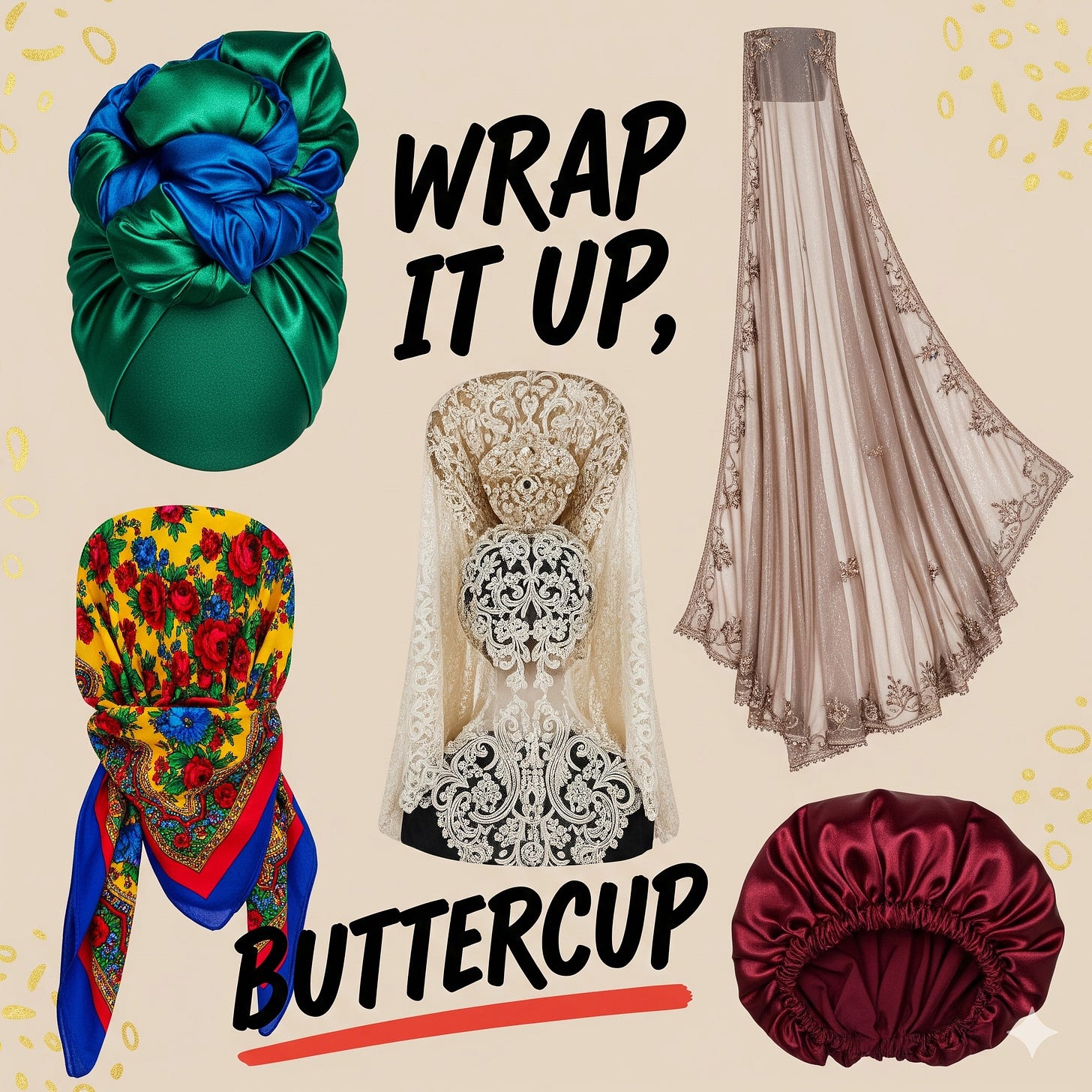Wrap It Up, Buttercup
The Global History (and Hype) of Hair Wrapping

Listen, if you think hair wrapping is just some “new TikTok hack,” I’ve got news for you—it’s older than your grandma’s cast iron skillet. People have been wrapping, tying, and covering their hair for centuries, across every culture, and for good reason: hair needs protection.
So let’s spill the tea (herbal, of course) on where hair wrapping started, why people did it, and why you should absolutely stop sleeping raw-dogging your pillow with unprotected hair.
🌍 Africa & the Caribbean: The Blueprint
African women were wrapping hair long before Sephora started stocking “silk bonnets” for $40 a pop. Scarves weren’t just practical—they were powerful. They kept hair safe from brutal sun and dryness, but they also carried deep cultural and spiritual meaning.
When slavery ripped people from their homelands, wraps became survival. They preserved hair when combs, oils, and tools were out of reach, and they doubled as cultural armor in a world trying to erase identity. That’s why today, in African American culture, the nighttime wrap is still a sacred, stylish, and smart tradition.
🕊️ Europe: Enter the Babushka
Meanwhile in Eastern Europe, Polish, Russian, Ukrainian, and German women were out there tying babushkas (scarves) under their chins like it was their job. Why? Farming, walking in freezing winds, or just surviving smoky kitchens. Bonus points: you looked like you were ready for Sunday mass at any moment.
While not usually worn at night, babushkas did the same thing—kept hair neat, clean, and out of the soup. Practical queens.
🌸 Asia: Beauty, Status, and Spirituality
In Asia, hair wrapping also had its moment. In Japan and China, elaborate hairstyles weren’t just for fun—they were literal works of art. Fabric wraps kept those masterpieces from falling apart while you slept.
Over in India, hair has always been seen as sacred. Women often covered it with dupattas or scarves—not only for modesty, but also as a sign of respect and spiritual grounding. And let’s be real—it also kept long, luscious locks from turning into a rat’s nest by sunset.
☀️ Spain & Mexico: Lace, Rebozos, and Sun Protection
Spanish women brought the mantilla—a lacy, dramatic veil that said, “Yes, I’m holy, but also glamorous.” In Mexico, the rebozo was the go-to: part shawl, part head covering, part multipurpose tool. Women wore them while working in the fields, cooking, or carrying babies. Hair stayed clean, protected, and shaded from the scorching sun.
Again, not a nighttime ritual, but the vibe was the same: protect the crown, honor tradition, and multitask like a boss.
💆 Why Bother Wrapping Now?
Because your hair deserves better than being sandpapered by a cotton pillowcase. Wrapping at night:
Saves your ends from breakage and split ends.
Locks in moisture instead of letting your pillow suck your strands dry.
Keeps curls, braids, blowouts, or silk presses from looking like you stuck a fork in an outlet.
Makes mornings easier (less detangling = more time for coffee).
🧵 What to Actually Wrap With
Here’s the real talk:
Silk → Fancy, breathable, the gold standard. Worth every penny.
Satin → Budget-friendly, still gets the job done.
Cotton → Absolutely not. That’s like drying your hair with sandpaper and then wondering why it’s breaking.
And if you can’t commit to wrapping? At least get yourself a silk pillowcase. Minimal effort, maximum payoff.
🎀 Wrap vs. Bonnet
Wrap = A scarf you tie yourself. Sleek, customizable, and makes you look like you could either go to bed or rob a bank.
Bonnet = A satin cap with elastic. Roomy, comfy, and looks like you’re about to churn butter in Little House on the Prairie—but your hair will thank you.
Both work. Pick your poison.
✨ The Universal Thread
From African head wraps to Polish babushkas, Asian dupattas to Mexican rebozos, women across the globe have been saying the same thing: protect the damn hair.
It’s not just a beauty hack—it’s history, identity, self-care, and straight-up practicality. So whether you’re slipping into silk at night or tying up your scarf old-school, know this: you’re keeping a tradition alive that spans continents and generations.
And if your hair could talk, it would probably say: “Finally. Took you long enough.”
🔥 So here’s your CTA: Go buy a silk scarf or bonnet. Your split ends are begging you. Your morning mirror-self will thank you. And your pillowcase? Well, it’ll just have to get used to rejection.
💌 PSA for Your Hair (and Sanity): If you just learned more in this post than you ever did scrolling TikTok at 2 a.m., then you should probably subscribe. My readers get the good stuff first—recipes, wellness hacks, and the blunt truth nobody else is saying out loud.
Hit that subscribe button. Your hair, your health, and honestly your whole vibe will thank you.
👯♀️ And hey—don’t gatekeep. Share this with your people. Your mom, your bestie, your cousin who still swears by her crunchy cotton pillowcase—let’s spread the gospel of good hair together.

